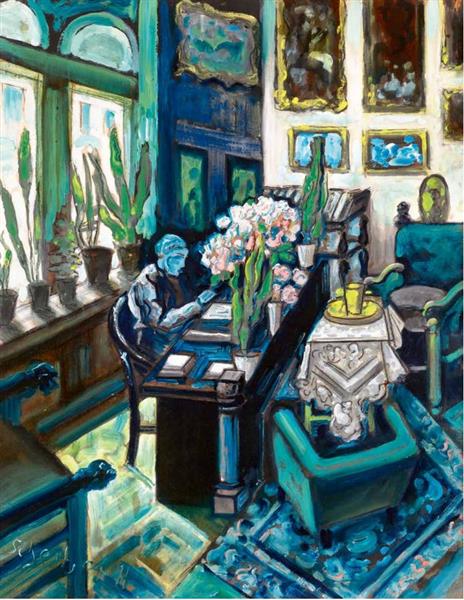Description
The work "Kék Szobaban 1940" by Hugó Scheiber is a fascinating testimony of the talent of the Hungarian painter, whose career covered from the interwar period until the decades after World War II. In this painting, Scheiber uses a predominantly blue palette, a feature that becomes a palpable symbol of the introspective and melancholic atmosphere that surrounds the work. The depth and variability of blue tones evoke not only serenity, but also an emotional distance sensation, hinting at the complexity of the artist's internal world and his reflections on life.
From a compositional point of view, the painting is configured around simplicity that, far from being trivial, enhances the essence of what is presented. In the center of the work there is a female figure that feels quietly, with a contemplative expression. This figure, with its relaxed but distant posture, invites the viewer to reflection. The way in which it is integrated into the blue space of the room reinforces the feeling of isolation, suggesting a dialogue between loneliness and introspection, a recurring theme in the art of the time. The figure is arranged in a family environment that could be interpreted as an intimate artistic space, where the aspect of everyday life is highlighted through color care and texturization.
In addition to the central figure, the background of the work is full of various elements that enrich the visual narrative without distracting the eye of the viewer. Indeterminate objects are perceived that, although relegated to the background, contribute deeply to the general sense of the situation presented. This use of the composition not only blurs the traditional lines between the subject and the context, but also reflects the influence of modern art on Scheiber's work, which often incorporates elements of abstraction.
What really highlights in "Kék Szobaban 1940" is Scheiber's ability to fuse figuration with more abstract aspects, something characteristic of the movement of which he was part, neo -impressionism. Through his technique of loose brushstrokes and vibrant colors, his work comes to communicate complex emotions that transcend the mere visual representation. His style, although rooted to reality, evokes a sense of deep emotional exploration, combining light and color to generate a resonance that goes beyond the surface.
Hugó Scheiber, who had formed in a rich and varied artistic context, knew how to absorb influences of symbolism, fauvism and realism, creating his own voice that differentiated him in the Hungarian artistic landscape. "Kék Szobaban 1940" is inscribed in this trajectory, representing a time when art became a vehicle to explore subjectivity and human experience in uncertain times.
In conclusion, the work not only serves as a reflection of Scheiber's technical mastery, but also offers a space for the meditation of the spectator about loneliness, introspection, and the emotional landscape of human existence. Its ability to capture the essence of time and the place where it was created makes "Kék Szobaban 1940" a significant piece not only of the artist's repertoire, but also of the history of modern art in Hungary.
KUADROS ©, a famous paint on your wall.
Hand-made oil painting reproductions, with the quality of professional artists and the distinctive seal of KUADROS ©.
Art reproduction service with satisfaction guarantee. If you are not completely satisfied with the replica of your painting, we refund your money 100%.

